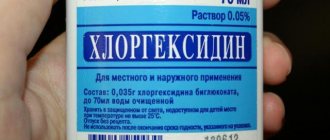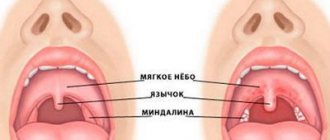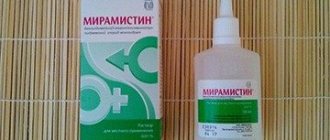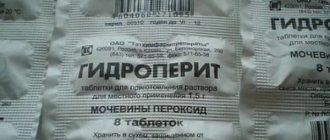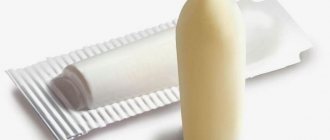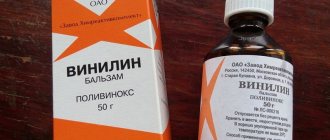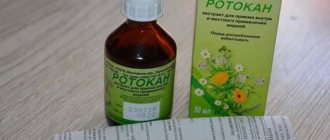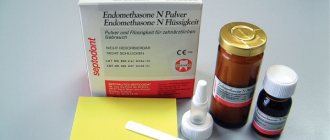Author of the article:
Soldatova Lyudmila Nikolaevna
Candidate of Medical Sciences, Professor of the Department of Clinical Dentistry of the St. Petersburg Medical and Social Institute, Chief Physician of the Alfa-Dent Dental Clinic, St. Petersburg
According to statistics, every second person on the planet has suffered from gum inflammation at least once. It is not surprising: the modern rhythm does not allow us to properly care for the oral cavity; bacteria accumulate between the teeth and begin to actively multiply, which leads to various pathologies.
One of the most popular remedies for gum inflammation is the well-known Miramistin. This powerful solution will quickly destroy harmful bacteria and return you to normal life. But how do you know when it’s time to start rinsing? How to carry out the procedure correctly? Let's figure it out together.
What does Miramistin help with?
According to the instructions included with each package of medication, the medicine is effective in the following cases:
- for the purpose of preventing suppurative processes in surgery and traumatology, as well as to accelerate the regeneration of purulent defects;
- complex therapy of purulent-inflammatory pathologies of musculoskeletal structures;
- therapeutic measures, as well as the prevention of defects obtained during labor, infectious and inflammatory processes in the genital structures - the main directions in obstetrics and gynecology;
- in dermatology and venereology, the drug “Miramistin” can be used not only for the treatment, but also for the prevention of various pyoderma, dermatomycosis, as well as candidiasis of integumentary tissues and mucous membranes, for example, thrush;
- Urologists recommend the medication when diagnosing urethritis or urethroprostatitis; it is practiced both in acute cases and in cases of chronicity of the pathological process;
- in dental practice, the drug treats various infectious and inflammatory processes localized in the oral cavity - stomatitis, gingivitis, periodontitis, treatment of removable dentures is possible
Can Miramistin be used for children under 1 year of age?
The instructions for use of the medication contain information that it can be given to children over 3 years of age. For this reason, many parents have a question about whether it can be used when most pediatricians prescribe Miramistin to newborns and children up to one year old. This purpose is due to the fact that the drug is harmless to the health of the child. Doctors often recommend that parents use Miramistin for painful throat conditions in children, including children under 1 year of age and newborns.
Even a small amount of medicine can alleviate the child’s condition. For babies under 1 year of age, it is used topically. Immediately after use, it reduces the inflammatory process in the throat mucosa. Unlike other medicinal liquids, it cannot be given to infants. Pediatricians only recommend spraying it so that it dissolves throughout the mucous tissues in doses that are safe for the small body.
Instructions for use of Miramistin for infants
Miramistin has an active antifungal and bactericidal effect. It is a fairly powerful antiseptic that can be used by babies from the first months of life. The range of application of the drug is very extensive:
- the first manifestations of colds and acute respiratory viral infections;
- thrush;
- damage to the skin;
- conjunctivitis;
- stomatitis;
- gingivitis;
- pneumonia;
- laryngitis;
- angina.
Very often, this remedy is used for preventive purposes when there is a risk of contracting viral infections.
To treat infected wounds for children under one year of age, apply the solution to a napkin or gauze and apply a compress to the affected area. A big problem is applying the product to the throat mucosa of a newborn. There is no need to dilute the product before use, since it is already ready to actively combat harmful bacteria and microbes.
There are several ways in which Miramistin can be administered to infants in the throat:
- It is recommended to spray the solution on the pacifier and give it to the baby; it, along with saliva, will fall on the mucous membrane of the throat;
- you can wrap gauze soaked in Miramistin on your finger or spatula and then wipe the mucous membrane;
- For treatment, cotton swabs soaked in a solution of the medicine are also used, but a single dose should not exceed more than 5 drops of the product;
- instillation into the nose should be performed once a day and only after rinsing the nasal passage with saline or saline;
- using a spray bottle, if the baby manages to insert the tip of the bottle into his mouth.
In severe cases of gingivitis and stomatitis, it is necessary to apply the medicine directly to the affected areas. It is best to perform the procedure immediately after feeding the baby. You need to prepare the oral cavity by treating it with water and then apply the product 3-4 times a day. To treat the respiratory system, it is good to use the medicine using an inhalation nebulizer.
Contraindications and application features
Failure to comply with the dosage can lead to increased dryness of the baby's mucous membranes. Immediately after treatment, a slight tingling sensation appears, which often causes discomfort for infants. If you are hypersensitive to the main substance, it is not recommended to use Miramistin.
Despite the fact that the drug is practically safe, it can cause an allergic reaction in a child if his body is too sensitive. If parents know about this, they should notify the pediatrician in advance. Hypersensitivity is the only contraindication to the use of Miramistin.
Almost always, the child’s body reacts positively to the use of the product. Its effect can be noticed after 4-5 procedures. If the baby accidentally swallows the permissible dose of the solution, nothing terrible will happen. It settles in microscopic drops in the nasopharynx and does not cause poisoning.
This universal remedy always copes with many diseases that children are often exposed to. It should always be in the home medicine cabinet of a family with children.
For sore throat
The active component of miramistin does not enter the systemic circulation, as it is not able to be absorbed through the mucous membranes. The drug has an exclusively local effect, destroying pathogenic microorganisms such as viruses, fungi, gram-positive and gram-negative bacteria, as well as pathogens of sexually transmitted diseases. As a drug for monotherapy, such a drug does not always justify itself, but if it is used in combination with other drugs, it is possible to achieve an enhanced therapeutic effect. Miramistin itself can have the following beneficial effects for sore throat and other associated symptoms:
- relieving swelling of throat tissue;
- elimination of pathogenic microflora;
- increasing local immunity of affected tissues;
- anti-inflammatory effect;
- acceleration of tissue regeneration processes.
The peculiarity of this drug is its selective effect, in which there is no effect on healthy tissue. All activity of the product is aimed only at areas of the mucous membranes affected by pathogenic microorganisms.
Lugol's solution is a product based on molecular iodine, which is used, as a rule, for irrigation and lubrication of the mucous membrane of the pharynx, larynx, and oral cavity in the case of infectious and inflammatory diseases. Read more in the article: “how to smear with Lugol correctly.”
Analogs
Other medications from the antiseptic group can serve as a substitute, for example:
Yox
This spray based on povidone-iodine and allantoin is used for sore throat and stomatitis from the age of 8, and the solution is prescribed from the age of 6.
Hexoral
This hexethidine preparation in the form of an aerosol or solution is used from 3 years of age. It is in demand for infections of the throat and mouth.
Hexasprey
This aerosol containing biclotymol is used for patients over 6 years of age. It is prescribed if a child has stomatitis, tonsillitis, glossitis and other bacterial lesions of the oropharynx.
Important Closed pneumothorax - symptoms, treatment and first aid
These eye drops are used for bacterial eye infections - for children over 3 years of age.
Kameton
This combination remedy, which contains camphor, menthol, chlorobutanol and eucalyptus oil, is prescribed from the age of five. The aerosol helps get rid of rhinitis and sore throat.
Lysobacter
This tablet drug is used for pain and inflammation in the mouth and throat - from 3 years of age. It includes lysozyme supplemented with pyridoxine.
Betadine
This solution, containing povidone-iodine, can replace Miramistin during surgical procedures, skin infections, wounds, burns, and so on. For children it is used from 4 weeks of age.
Vinylin
The effect of this solution is provided by polyvinox. The drug is recommended for skin infections, open wounds, bruises, diaper rash, chickenpox, stomatitis and many other lesions. Doctors prescribe it to children of different ages.
Miramistin-Darnitsa
A drug based on miramistin with the same name is available (in the form of an ointment). The product has a disinfectant effect and is in demand in the practice of surgeons and traumatologists.
It is used:
- for the treatment of purulent wounds;
- to prevent secondary infection of wounds;
- in the treatment of severe burns;
- with keratomycosis;
- with candidiasis of the mucous membrane or skin;
- with onychomycosis;
- with streptoderma;
- when the skin is damaged by staphylococcus;
- with a fungal skin infection.
The medicine is released in tubes containing 15 g of a homogeneous light substance. The concentration of miramistin in the ointment is 5 mg/1 g. This active ingredient is supplemented with propylene glycol, macrogol, disodium edetate, purified water and poloxamer.
The only contraindication to the use of such a drug is hypersensitivity to any component of the ointment. This drug is not prescribed to children, since its effect on the children's body has not been studied. But in fact, the drug is used because it extremely rarely causes side effects and acts mainly locally.
More information about this drug is in the video below.
Is Miramistin an antiseptic?
The mechanism of the therapeutic action of Miramistin is based on its surface-active properties. The active substance is capable of interacting with lipids in the membranes of pathogenic microorganisms. In this case, the antiseptic molecule practically penetrates into the membrane and contributes to its destruction. As a result of the active activity of the antiseptic, the attacked cell dies. A completely unique property of Miramistin can be called its selectivity. The drug perfectly “recognizes” healthy cells of the human body and does not react to them in any way.
Scientists were able to explain this “phenomenon”: in fact, it is due to the special structure of the cell membranes of our body.
The antiseptic was synthesized back in the 70s of the last century, during the rapid development of Soviet space. The researchers faced a difficult task: they had to create a product that could be used both to treat the hands of astronauts and to disinfect the surfaces of a spacecraft. Particularly difficult was the fact that the antiseptic was planned to be used in difficult conditions of weightlessness.
One of the main representatives of the pharmacological group of psychostimulants and nootropic drugs is Piracetam. It improves cognitive functions and blood supply to the brain, and accelerates metabolic conditions in it. Read more in the article: “what does piracetam help with?”
How the drug works
This drug is a drug that has a bactericidal effect when applied topically. Numerous studies have proven that the product is effective against most known pathogens of stomatitis - it affects bacteria, pathogenic fungi, and most viruses that can damage the mucous membrane.
At the same time, the active substance of the drug does not interact with the epithelium lining the oral cavity and does not damage the cell structure.
The medicine has a huge advantage - the drug is sold in pharmacies, ready for use, and it can be used as prescribed by a doctor without any additional manipulations. You do not need a prescription to receive Miramistin.
How to gargle?
How to use Miramistin correctly? How to gargle for an adult? Interested in answers to these questions? Then let's study the instructions for the correct use of this antiseptic drug:
- We carry out any manipulation related to gargling no earlier than 30 minutes after eating.
- First, rinse the oral cavity with clean water.
- An adult does not need to dilute Miramistin. The concentration of the drug will not cause harm.
- For one manipulation you will need an average of 10-15 ml of solution.
- During rinsing, do not swallow liquid under any circumstances.
- To achieve a positive result, the procedure must last at least 5 minutes.
- Throughout the rinsing, we try to pronounce the sound “y”.
Specialized doctors advise performing the described manipulation 5-6 times a day at regular intervals. If you start treatment in a timely manner, you will forget about discomfort and pain after 2-3 days. In some, as they say, advanced cases, treatment can take up to one week.
Rules for the inhalation procedure
The therapist will prescribe inhalation procedures if the runny nose is infectious in nature. This may be indicated by green snot and other signs.
Important: following the preparation rules will help increase the effectiveness of treatment. To choose the right size mask, you need to make sure that the device covers your nose and mouth well. Sterilization of all removable elements will allow you to avoid infection through the inhalation device.
To make breathing easier, you should use special means 10 minutes before inhalation. The procedure itself lasts the same amount of time. To achieve results, you must resort to it three times a day. And the entire course of treatment lasts no more than five days.
For thrush in women
The active substance Miramistin exhibits activity against protozoa, fungi, and yeast-like infections. Therefore, the drug is used in complex therapy for vaginal candidiasis. Therapy will be more effective if Miramistin is used in combination with other antifungal drugs for local and systemic effects on the fungus, as well as probiotics. Before treating thrush, it is necessary to undergo a comprehensive examination and confirm the diagnosis.
At the first signs of candidiasis: itching, burning, discomfort, white cheesy discharge, it is recommended to refrain from self-medication and consult a doctor. The specialist will conduct an in-person examination and a comprehensive examination, identify the causative agent of the pathological process and prescribe an appropriate treatment regimen. You can also find out from him whether Miramistin can be used. The earlier high-quality therapy for vaginal candidiasis begins, the more favorable the prognosis.
Side effects and contraindications
Side effects from using the drug include the risk of developing an allergic reaction. It occurs very rarely and most often affects young patients. A burning sensation may occur during use. This phenomenon is considered normal and does not require refusal from further use.
Contraindications include individual intolerance of the body to the components of the drug, which occurs in the presence of certain types of allergies and dermatitis. In any case, Miramistin should be taken under the supervision of a specialist.
Is it possible to spray in the nose?
Miramistin can be used both for the prevention of diseases and for treatment - in the form of drops or inhalations into the nose. It is used at the first signs of sinusitis, for rinsing the nose during the puncture of the maxillary sinus, and is also used for a disease that was caused by bacteria. In the absence of proper treatment for sinusitis, bacteria spread further, affecting surrounding tissues, which leads to complications. Under no circumstances should you self-medicate at the first signs of a runny nose.
Any drug can only be recommended by a doctor.
The medicine effectively fights various microbes, including bacteria that enter the human body from the environment and any fungi (axomycetes, dermatophytes). When using this drug to treat a runny nose, it must be taken into account that it can negatively affect the nasal mucosa. This solution should be used with extreme caution when children have a runny nose. Getting into the surface of the nasal passage, the drug creates a film that protects against infection. The drug is not absorbed orally, so it does not have any negative effect on the body.
Special instructions for the use of the drug Miramistin
The drug does not have a local irritant effect and does not have allergenic properties. Venereology. Urology. After treating the urethra, vagina, inner thighs, pubis and genitals with miramistin, it is not recommended to urinate for 2 hours. Use during pregnancy and lactation. Since drug resorption is almost completely absent, Miramistin can be used during pregnancy and lactation. The ability to influence the reaction rate when driving a vehicle or working with other mechanisms. During treatment with the drug, it is possible to drive vehicles and engage in other potentially hazardous activities that require increased concentration and speed of psychomotor reactions.
Is it possible to rinse your nose?
Miramistin acts locally. It has a pronounced antiseptic property. Therefore, it kills aerobic and anaerobic organisms in the nasal cavity. It also acts fatally on Pseudomonas aeruginosa, gonococcus, E. coli, and staphylococcus. The components of Miramistin kill even strains that are resistant to standard antibiotics. The medicine also destroys some types of viruses. The main one of these types is herpes.
Miramistin also has a pronounced antifungal effect, so it is used for the treatment of candidiasis. Miramistin does not relieve allergic reactions. Using Miramistin for a runny nose has the following advantages:
- Destruction of viruses, fungi and pathogens;
- Pronounced anti-inflammatory effect;
- Development of greater sensitivity to the effects of other medications;
- Activation of the body's immune functions;
- No effect on the mucous membrane - does not cause discomfort;
- Does not affect the functioning of viable cells.
Miramistin shows an excellent effect in the fight against bacterial rhinitis, sinusitis, laryngitis and sore throat.
How is the drug released?
There are several different forms of release of the drug. This allows you to choose the most convenient option for use for each individual patient. It is better to rinse your gums with Miramistin in the form of a solution, and, for example, use the ointment during the treatment of herpetic manifestations on the skin.
Solution
One of the most effective and convenient forms of the drug. Proper use allows you to cover the entire inflamed part of the gum or mouth. In addition, the solution can be used not only for rinsing, but also for making lotions and performing douching and wiping. The downside is that it is difficult to use for treating young children, since it is difficult for them to keep the liquid in their mouth and not swallow. For kids, it is better to choose other release options.
Spray
This is the same antiseptic solution, only the packaging is different. A special nozzle on the lid allows you to spray the medicine in hard-to-reach places on the gums, for example, when treating a small child who cannot rinse his mouth on his own. In this method, it is not always possible to cover all problem areas with Miramistin, unlike rinsing, when the entire oral cavity is susceptible to antiseptic influence.
Ointment
Miramistin in the form of an ointment is not used for gum inflammation, since this form is practically not fixed at the site of application, and there is a risk of swallowing the drug. In addition, the components of the ointment affect only the upper balls of the gums, without penetrating into deeper structures, so the therapeutic effect is practically absent. Ointment forms will be appropriate for the treatment of herpetic rashes on the skin.
Can I wash my eyes?
The list of indications does not include eye diseases. That is, the drug cannot be used according to the instructions. Many patients claim that Miramistin is prescribed by doctors for various conjunctivitis, and it helps a lot. It is recommended to apply the product to a clean swab, wipe the eye or drop 1-2 drops into each eye sac. The procedure is repeated up to six times a day. Treatment continues until complete recovery. On average this takes 5 days.
On the forums, a real “struggle” is unfolding around the question of whether it is possible to wash the eyes with Miramistin. Opinion was divided. Some readers claim that the solution is not intended for this and leads to corneal burns, while others argue that it is safe and effective. It is used not only for adults, but also for children. Interestingly, the opinion of doctors is similar. Some prescribe the drug, others do not. No clinical trials have been conducted. There is no official information regarding the effect of the drug on the mucous membrane of the visual organ.
How to use the product correctly?
The best results are achieved by rinsing. At first glance, the rinsing procedure seems quite simple, but not everyone knows the specifics of using Miramistin. An important rule is to follow the prescribed dose, taking into account the patient’s age. Do not forget that this is a medicine, and not a simple medicinal tea.
It is important to strictly follow the instructions for the drug
Sequencing
To achieve the desired effect, you should follow several rules.
| Rule | Description |
| Dosage | Do not under any circumstances exceed the dosage of the drug. Children under 14 years of age need to dilute the liquid with water (2-3 tablespoons). |
| Proper rinsing | While rinsing, you need to tilt your head back slightly. Microorganisms along with the drug can accidentally penetrate the nasal passages, which will only increase the number of existing problems. In the worst case, you can “earn” otitis media. Gargling should be done very carefully. There is no need to blow bubbles, hiss and strain your throat like a small child. This will not increase the effect of Miramistin. When rinsing, try to keep the lower jaw slightly forward. This way, the Miramistin composition will be able to penetrate hard-to-reach places. |
| Swallowing medication | Do not swallow the product after rinsing. A person will not get poisoned this way, but you should not bother your stomach with unnecessary chemicals. The product must be spat out. |
| Storage | You should not store the product in the refrigerator - the storage location should be maintained at room temperature. Half an hour after rinsing, you should not eat or drink water or other liquids. Otherwise, the film of the medicine along with the food will end up in the stomach, and the effect will be zero. You need to wait for Miramistin to begin its anti-virus action, which begins 10 seconds after rinsing. |
| Treatment frequency | It is recommended to rinse your mouth for 2-4 minutes 2-3 times a day. For children, 30-40 seconds will be enough. The treatment course with an antiseptic lasts from 5 to 7 days. If during this period the patient does not notice any improvement, it is worth re-making an appointment with the attending physician to prescribe a new treatment. |
It is important to rinse your mouth correctly
The recommendations are quite simple and will not cause difficulties if you follow them. Do not forget that any microorganisms can adapt to any conditions. At some stage of the disease, the effect of the drug may stop. To prevent this from happening, you should alternate rinsing with an antiseptic and herbal infusions or soda-saline solution.
Dissolve 3 potassium iodine and 1 tsp in 1 glass of warm purified water. soda and salt. Stir everything well and leave to infuse for 15 minutes, after which you can use the product for its intended purpose.
Infusions of sage or chamomile also do not conflict with Miramistin. Alternating them will help achieve the desired result.
This is interesting: What are dental drops, and can they relieve pain?
You can alternate rinsing with Miramistin and herbal infusions
Recommendation ! Along with the antiseptic, a special nozzle should come in the package. You can also purchase a dropper, but it is usually difficult to capture the required amount of liquid. As an alternative, a regular spoon will do. Using these devices, it will be easy to determine the correct dosage.
Is it possible to swallow Miramistin?
What happens if you swallow Miramistin in small quantities during treatment procedures? It all depends on how much of the drug a person swallowed and how his body tolerates the active substance. If a similar remedy has already been used before and there were no allergic reactions, then most likely the unsuccessful procedure will pass without consequences, the maximum that can occur is nausea, which will quickly pass.
To avoid swallowing Miramistin, you need to adhere to the correct tactics for using the medication, which will be described by your doctor.
If you swallow Miramistin when irrigating your throat for the first time, you may develop an allergy. But it will be associated with the body’s reaction to the drug, and not with ingestion. Getting Miramistin into the gastrointestinal tract can only slightly aggravate the condition. And when treating small children, it is better to use a spray rather than a gargle solution. Although it covers a smaller surface, it prevents accidental swallowing of the product. Most often, swallowing Miramistin does not affect the patient’s condition in any way and does not require assistance. To avoid unpleasant incidents, you need to follow your doctor's instructions and gargle correctly.
Side effects
Patients and doctors note the high degree of safety of the drug. Serious side effects from its use are rare.
However, this only applies to the case when the drug is used externally. It should be remembered that Miramistin is not an antibiotic and cannot be taken orally. The instructions for the drug do not say anything about whether accidental ingestion of the drug is dangerous, for example, if the patient gargles with it. Most likely not, but you shouldn’t do it intentionally. It is unknown how the gastrointestinal tract may react to the substance entering it. Irritation of the mucous membrane of the esophagus or stomach is possible.
However, in some cases, Miramistin can cause allergic reactions, redness of the skin, and burning at the site of application.
If a burning sensation is observed for 15-20 seconds and then goes away on its own, then discontinuation of the drug is not required. If unpleasant symptoms do not go away, then use of the drug must be stopped.
Another advantage of the drug is its lack of odor. But regarding the taste of the drug (when used to treat oral infections), opinions are divided. Some argue that the drug has no taste, others claim that the drug has a not very pleasant, but still not unpleasant, aftertaste. This may be due to the fact that the drug can cause a temporary disturbance in the sense of taste.
Miramistin is also gentle on the skin and mucous membranes, does not cause irritation, and does not change their color, unlike many other antiseptics. However, here it is necessary to remember to comply with the doctor’s instructions. If the drug is used systematically for a long time (more than 10 days), for preventive purposes, the patient may develop dysbiosis and associated inflammation of the mucous membranes or skin.
In addition, the standard Miramistin solution is not intended for instillation into the eyes. For this purpose, there is a special drug containing Miramistin - Okomistin.
Does Miramistin help or not against coronavirus?
At the beginning of the pandemic, Miramistin was not studied as an antiseptic to combat Covid-19 pathogens. Only formulations based on 75% ethanol (alcohol) were recommended. But when alcohol-containing antiseptics disappeared from store shelves and pharmacies, virologists began to study other types of drugs in this group. Miramistin turned out to be one of the most effective. In the course of the studies, the ability of the main active ingredient of the drug (benzyldimethine) was proven to destroy coronavirus cells that have come into contact with the skin, objects, and clothing.
As a medicine for the treatment of those already infected with Covid-19, Miramistin did not show the desired effectiveness. The principle of its action is based on superficial treatment of the affected areas of the mucous membranes. The product does not penetrate deep into their structure. The community of epidemiologists and virologists has confirmed that Miramistin against coronavirus can be used as a prophylactic agent, but only if combined (alternating) with alcohol-containing antiseptics. Miramistin is definitely not capable of curing Covid-19, but it can be used as an antiseptic to treat:
- gadgets,
- protective equipment,
- smooth surfaces,
- plastic cards.
It is important to understand that Miramistin will not provide complete protection against coronavirus. It cannot be used as the main antiseptic for a long time, including for disinfecting household items in a house where a person infected with Covid-19 is undergoing home treatment.
Can Miramistin be used for children under 1 year of age?
The instructions for use of the medication contain information that it can be given to children over 3 years of age. For this reason, many parents have a question about whether it can be used when most pediatricians prescribe Miramistin to newborns and children up to one year old. This purpose is due to the fact that the drug is harmless to the health of the child. Doctors often recommend that parents use Miramistin for painful throat conditions in children, including children under 1 year of age and newborns.
Even a small amount of medicine can alleviate the child’s condition. For babies under 1 year of age, it is used topically. Immediately after use, it reduces the inflammatory process in the throat mucosa. Unlike other medicinal liquids, it cannot be given to infants. Pediatricians only recommend spraying it so that it dissolves throughout the mucous tissues in doses that are safe for the small body.
Miramistin has an active antifungal and bactericidal effect. It is a fairly powerful antiseptic that can be used by babies from the first months of life. The range of application of the drug is very extensive:
- the first manifestations of colds and acute respiratory viral infections;
- thrush;
- damage to the skin;
- conjunctivitis;
- stomatitis;
- gingivitis;
- pneumonia;
- laryngitis;
- angina.
To treat infected wounds for children under one year of age, apply the solution to a napkin or gauze and apply a compress to the affected area. A big problem is applying the product to the throat mucosa of a newborn. There is no need to dilute the product before use, since it is already ready to actively combat harmful bacteria and microbes.
Important Streptococcus in the throat: symptoms and treatmentThere are several ways in which Miramistin can be administered to infants in the throat:
- It is recommended to spray the solution on the pacifier and give it to the baby; it, along with saliva, will fall on the mucous membrane of the throat;
- you can wrap gauze soaked in Miramistin on your finger or spatula and then wipe the mucous membrane;
- For treatment, cotton swabs soaked in a solution of the medicine are also used, but a single dose should not exceed more than 5 drops of the product;
- instillation into the nose should be performed once a day and only after rinsing the nasal passage with saline or saline;
- using a spray bottle, if the baby manages to insert the tip of the bottle into his mouth.
In severe cases of gingivitis and stomatitis, it is necessary to apply the medicine directly to the affected areas. It is best to perform the procedure immediately after feeding the baby. You need to prepare the oral cavity by treating it with water and then apply the product 3-4 times a day. To treat the respiratory system, it is good to use the medicine using an inhalation nebulizer.
Failure to comply with the dosage can lead to increased dryness of the baby's mucous membranes. Immediately after treatment, a slight tingling sensation appears, which often causes discomfort for infants. If you are hypersensitive to the main substance, it is not recommended to use Miramistin.
Despite the fact that the drug is practically safe, it can cause an allergic reaction in a child if his body is too sensitive. If parents know about this, they should notify the pediatrician in advance. Hypersensitivity is the only contraindication to the use of Miramistin.
Almost always, the child’s body reacts positively to the use of the product. Its effect can be noticed after 4-5 procedures. If the baby accidentally swallows the permissible dose of the solution, nothing terrible will happen. It settles in microscopic drops in the nasopharynx and does not cause poisoning.
How to use in the intimate area?
Miramistin is a universal antiseptic that is prescribed for the following intimate diseases:
- gonorrhea;
- chlamydia;
- trichomoniasis;
- syphilis;
- genital herpes;
- candidiasis;
- vulvovaginitis;
- endometritis;
- postpartum injuries with suppuration;
- postpartum infections.
Miramistin is used not only in the treatment of sexually transmitted infections, but also as a means of preventing STDs after unprotected sex. Miramistin is applied directly to the genital area. Do this according to the instructions.
- The bottle is removed from the packaging. It is not necessary to shake the medicine.
- A suitable nozzle or applicator is installed on the packaging.
- The medicinal solution is applied to the affected area by pressing the nozzle.
Men need to use a urological applicator to inject the solution into the urethra. Women treat the urethral area and vagina. Additionally, you may need to spray an antiseptic in the anus area and on the inner thighs. This treatment mechanism will protect against sexually transmitted infections. Miramistin alone is not enough to treat STDs. The antiseptic will play the role of an auxiliary element of therapy.
Important Tips
The solution is contained in a plastic bottle. It is very convenient to carry, it will not break and will not injure you from fragments.
If you accidentally shake the bottle or actively rinse your mouth, the solution will begin to foam violently. Don't be scared - this is a normal reaction. To avoid this, you should not actively “gurgle” your larynx while rinsing.
Notice ! It is important that the solution completely covers the throat and does not form foam.
If purulent ulcers form due to pathologies of the tonsils or throat, this does not interfere with the action of the drug. On the contrary, the medicine cleanses well and quickly heals these wounds and prevents the appearance of new ones.
Miramistin can relieve inflammation
It is worth knowing that Miramistin does not have an analgesic effect, but it perfectly relieves inflammation, which is the causative agent of pain.
There may be a slight burning sensation that quickly subsides. They are determined by the composition of the product.
A distinctive feature of the antiseptic is that it does not change with changes in temperature and light. This does not mean that you can safely leave it in the refrigerator or under the rays of the scorching sun. But warming up the solution a little before rinsing is allowed.
Miramistin does not have a strong smell or taste, which makes it an ideal medicine for children, since they are often picky when they hear an unpleasant smell or feel an unpleasant taste.
If the child is not yet a year old and he constantly uses a pacifier, then you can dip it in the product and give it to the baby. Thus, the composition will end up in the child’s mouth and spread throughout the mucous membrane.
You can dip the pacifier in the product so that it ends up in the baby’s mouth
Important ! Do not give the drug in spray form to infants. He may get scared, resulting in a spasm, which will become an additional problem.
"Miramistin" is a surface-active drug. It can be combined with other medications, especially since it is compatible with many well-known disinfectants.
It is worth remembering that this is, first of all, a medicine. Self-treatment can only worsen the situation, so you should definitely check with a doctor.
Sources:
- https://pillsman.org/24157-miramistin-dlya-desen.html
- https://imdent.ru/miramistin-primenenie-polosti-vospalenii/
- https://stomatdoc.ru/miramistin-pri-zubnoj-boli.html
- https://spas-dent.ru/rot/kak-poloskat-rot-miramistinom-pri-vospalenii-desen.html
- https://dentalclinicmsk.ru/zabolevaniya/stomatit/kak-poloskat-rot-miramistinom.html
- https://kcdc.ru/preparaty/miramistin-sprej-dlya-gorla-detyam.html
- https://CreateSmile.ru/miramistin-pri-stomatite/
- https://kcdc.ru/hirurgiya/miramistin-dlya-poloskaniya.html
- https://denta-da.ru/poloskat-miramistinom-vospalenii-desny/
- https://24stoma.ru/miramistin-instrukciya-po-primeneniyu.html
Miramistin for inhalation with nebulizer
This procedure is recommended to be carried out through an ultrasonic nebulizer. Thanks to the influence of ultrasonic waves, the active substance is sprayed into small particles that penetrate the respiratory tract, where they begin to exert their therapeutic effect. The particles sprayed in the nebulizer are so small that they are not able to burn the mucous layer of the respiratory tract. It is this quality that allows us to consider inhalations performed using an ultrasonic nebulizer to be the safest and most effective.
The procedure has the greatest effect if it is carried out at the very beginning of the development of the disease.
Inhalation in adults should last about 15 minutes, while breathing at moderate intensity.
This allows you to relieve inflammation, neutralize bacterial agents and avoid various complications of pathology. Inhalations with Miramistin are usually used in complex treatment of the disease. This remedy best resists ailments such as sinusitis or polysinusitis. Miramistin for inhalation with a nebulizer is able to destroy the bacterial environment and improve the condition of the mucous layer.
In what cases are rinses ineffective?
Knowing what to rinse your mouth with when your gums are inflamed is not enough to cure their inflammation. Various mouth rinses (even the strongest ones), as well as various gels for gums, are only auxiliary means, and will never be able to cure inflammation on their own once and for all. There are 2 main types of gum inflammation – gingivitis and periodontitis. Gingivitis is the initial stage of inflammation, the main symptoms of which are: swelling, redness or bluishness of the gums, pain and bleeding when brushing teeth, bad breath. With periodontitis, these symptoms are accompanied by mobility of teeth, suppuration from periodontal pockets, atrophy (destruction) of the bone tissue around the teeth.
The causes of the development of gingivitis and periodontitis are soft microbial plaque, as well as hard supra- and subgingival dental deposits. In fact, the main cause of inflammation is insufficient oral hygiene. Antiseptic rinses are actively used to treat gum inflammation, but they are only an aid. The main treatment, after all, is the removal of dental plaque by a dentist, after which, ideally, a course of gum treatment is carried out.
If dental plaque has not been removed, and you have started using antiseptic rinses and anti-inflammatory gels, the symptoms of inflammation will certainly decrease for some time. But the inflammation will certainly gradually return again as soon as you finish the course of rinses and applications. The danger of using anti-inflammatory rinses and gels in this case is that they only mask the symptoms of the disease (and the inflammation progresses unnoticed).
In complex therapy for the treatment of gum diseases, you can use not only rinses and gel applications, but also special anti-inflammatory toothpastes for gums, which will very quickly help you reduce bleeding and swelling of the gums. Some of these pastes are also suitable for long-term prevention of inflammation.
What can replace Miramistin?
Although the product can be called expensive only with a stretch, because its cost exceeds 250 rubles, there are still cheaper drugs related to antiseptics and used in ENT practice. Antiseptic solutions of domestic production:
- Chlorhexidine
- a solution used for inhalation and rinsing, only local use is permissible. The product is effective against E. coli, staphylococci and other bacterial pathogens. The cost is about 20 rubles.A narrow range of application does not always destroy the desired bacteria, so Miramistin will be more reliable. Miramistin or chlorhexidine, what are their similarities and differences? If we consider the scope of application, then there are no practically significant differences, because the list of medical areas is the same.
Due to the fact that the structure of the drugs is different, you can notice a slight discrepancy in the purpose (indications). The activity of chlorhexidine is slightly lower; unlike Miramistin, it is not sensitive to Koch's bacillus (tubin infection), Pseudomonas aeruginosa, and some Proteas. These pathogenic microorganisms require only potent antibacterial agents.
Miramistin and Okomistin, what is the difference?
Okomistin - eye drops with antimicrobial, antiseptic, antiviral effects. Active against different types of microorganisms - bacteria, viruses, fungi, protozoa and some other microbial agents (chlamydia). They are most effective against gram-positive species, including difficult-to-treat multidrug-resistant hospital strains. Under the influence of Okomistin, the resistance of fungi and bacteria to antibiotics is reduced.
The drug has an immunoadjuvant (strengthening the body's defense response), anti-inflammatory and regenerative effect. Moreover, due to its high selectivity, Okomistin does not act on human cells due to the difference in their structure from bacterial cells. Miramistin in Okomistin is about 0.01%, the auxiliary components are purified water and sodium chloride. Medicine is prescribed for pathological eye lesions.
Mestamidin or Miramistin, which is better?
Mestamidin contains two main components and a large number of auxiliary components, including coconut oil and glycerol. Accordingly, the risk of allergic reactions is higher. It is not recommended to insert it into the urethra or vagina; in case of contact with the eyes, rinse them with water. Children and pregnant women can use it. The drug cannot be combined with iodine-containing products. Miramistin is more effective against inflammation. It is produced both in the form of a spray and in the form of an ointment, which is convenient to apply to the skin. The drug is not prescribed to patients under 3 years of age, but it is safe for treating older children. Even if it gets into your eyes, nothing bad will happen, since it is also used in ophthalmology. It has no taste or smell, so it is convenient for gargling.
Mestamidin is cheaper than Miramistin by about 100 rubles. A 150 ml package of Miramistin costs from 327 to 359 rubles, and Mestamidin costs from 185 to 228 rubles.
Pregnant women can use Mestamidine. Therapists and otolaryngologists routinely prescribe Miramistin for gargling an inflamed throat, for example, with a sore throat. Mestamidine is an acceptable analogue, although with a different composition. Thanks to the spray bottles, these drugs can be used to irrigate inflamed tonsils. Mestamidin or Miramistin should be used together with other drugs; an antiseptic solution alone cannot cure the disease, but recovery can be accelerated.
Hexoral or Miramistin, which is better?
The main cause of various sore throats (sore throat, pharyngitis, laryngitis) is infection with bacteria, viruses and fungi. To treat these diseases, your doctor will usually prescribe topical antimicrobials. These include Hexoral and Miramistin, which are applied directly to the mucous membranes by rinsing or spraying. What is the difference between these drugs, and which one is better? The drugs contain different active ingredients, but due to the general antimicrobial effect they are prescribed for the same diseases. To choose the right product, you should highlight the advantages of each of them. Pros of Hexoral:
- variety of dosage forms:
- not contraindicated for young children;
- can be used by pregnant and lactating women without restrictions (Gexoral - only with the permission of a doctor).
additional analgesic effect.
Thus, for inflammatory diseases of the oropharynx, including sore throat, it is better to choose Hexoral. It will not only eliminate the cause of inflammation (pathogenic bacteria), but also relieve sore throat. Miramistin is preferable if treatment is required in a patient with hexetidine intolerance, a pregnant or lactating woman, or a child under 3 years of age.
Miramistin and Chlorhexidine, what is the difference?
When using Chlorhexidine, it must be remembered that it can provoke severe allergic reactions, as well as chemical burns of the mucous membranes. Its use may cause dry skin, itching and flaking. In addition, Chlorhexidine should not be used on open wounds if there is a risk of the drug getting into the medulla or auditory nerve. Chlorhexidine is also not allowed to come into contact with the eye membrane. Milk or raw egg can be used to reduce toxic effects. In light of this factor, there is no question whether it is possible to gargle with Chlorhexidine. Miramistin has far fewer contraindications and side effects. These include:
- Individual intolerance to the drug or its excipients;
- A burning sensation upon application (disappears after 10-15 seconds).
Which is cheaper? The advantage of Chlorhexidine is its price, which is several times lower. The price of Miramistin is in the range of 200-700 rubles. It depends on the volume and type of nozzle of the drug. The cost of a Chlorhexidine solution with a 0.05% concentration is 10-15 rubles. for 100 ml. Therefore, many patients think about which remedy is more effective - expensive or cheap. Only a specialist can answer this question.
Release form and composition
The medicine is presented as a clear solution that does not have any odor, taste or color. Such a liquid includes only two ingredients - the active substance, also called miramistin, and purified water. The concentration of the active compound is 0.01%.
In pharmacies you can see different packages of Miramistin, differing in both volume and attachments. In childhood, a bottle of 150 ml of medication is most often recommended, to which a nebulizer can be attached. But for the youngest patients, smaller packaging is also suitable - bottles of 50 ml of solution, which have two nozzles (urological and spray).
The shelf life of the medicine is 3 years and after its expiration the medicine should be thrown away. Storing the solution does not require any special regime - it is recommended to keep the package of medicine out of the reach of children at room temperature. You do not need a prescription to purchase Miramistin at a pharmacy. The average price of 150 ml of the drug is approximately 350 rubles.
For what throat diseases in pregnant women is it prescribed, how does it affect the fetus?
In the official instructions for Miramistin, pregnancy is not listed as a contraindication. On the antiseptic website in the “Questions and Answers” section, the manufacturer’s specialist explains that the active substance does not enter the bloodstream during local treatment, does not have a negative effect on the fetus, practically does not cause allergies and does not irritate the mucous membranes. Based on this, the solution can be used throughout the gestational period. Long-term clinical experience also proves the safety of the antiseptic in question during pregnancy.
Miramistin is prescribed by doctors for the following throat ailments:
- tonsillitis;
- angina;
- pharyngitis;
- laryngitis.
Moreover, if you start using Miramistin immediately when there is redness, mild pain and a sore throat, then further development of the disease, as a rule, can be avoided. Otherwise, the drug has to be used in complex therapy. In this case, it is possible to reduce the severity of painful manifestations, prevent the possibility of complications and shorten the duration of the disease.
One of the indications for the use of Miramistin is tonsillitis - acute inflammation of the tonsils.
In what form to apply
The following methods can be used to treat the mucous membrane of the throat with Miramistin:
- rinsing;
- irrigation with a spray nozzle;
- inhalation.
Rinsing is considered more effective, as it simultaneously mechanically cleanses the surface of the tonsils from dead bacteria and their waste products. Rinsing is also indispensable when pus forms. The spray is convenient for those who are at work and on the street, in transport and in cafes. Typically, the spray is used to treat children who are not yet able to gargle. Inhalations are prescribed if inflammation has affected the lower respiratory tract.
Miramistin can be used by pregnant women as a prophylaxis after communicating with a carrier of the infection, in severe epidemiological conditions in the region of residence, or after hypothermia.
Directions for use and doses
The method of application and dose of miramistin depend on the disease being treated and its symptoms. Let's look at the methods of use and dosage of miramistin in the treatment of the main indications for its use.
- If Miramistin is prescribed for disinfection of wounds, then a gauze bandage soaked in a 0.01% solution of the drug is applied to the affected area. When treating burns, an occlusive dressing is applied to the wound, which is generously moistened in a solution of the drug.
- When using the drug for osteomyelitis in the postoperative period, Miramistin is injected into the wound and fistula tracts through drainage or using gauze swabs. The procedures are carried out 3 times a day, for 5-7 days. Drainage of cavities and wounds using about one liter of miramistin solution per day shows high efficiency.
- When using an ointment, the drug is applied to the wound and a sterile bandage is applied. When treating purulent wounds and fistulas, gauze turundas with ointment are used. The dose of miramistin depends on the volume of affected tissue. The ointment is used 2 times a day until the desired therapeutic effect is obtained.
- To prevent postpartum infections, vaginal irrigation is used 5-7 days before childbirth and during the postpartum period.
- If Miramistin is used to treat lesions of the genital organs, use tampons that are soaked in miramistin solution. Electrophoresis is also possible for two weeks.
- For complex treatment of urethritis, 2-5 ml of the drug solution is injected into the urethra twice a day for 7-10 days.
- In the treatment of purulent sinusitis, Miramistin is used for puncture of the maxillary sinus. Gargling with a solution of the drug is also considered effective. To treat purulent otitis media, the drug is injected into the external auditory canal.
[], [], [], []
Miramistin during pregnancy in the 1st trimester
Miramistin during pregnancy in the 1st trimester can only be used with the permission of a doctor. Despite the fact that the drug's instructions allow it to be used during pregnancy at any stage, the drug has contraindications that can negatively affect the development of the child. Do not forget that not a single drug provides a 100% guarantee of absolute benefit and harmlessness. This suggests that miramistin, while providing a therapeutic effect for the mother, can cause minimal harm to her unborn child.
Directions for use and doses
1st trimester
At the first stage of pregnancy, Miramistin can be used only as prescribed by a doctor. Only a specialist will be able to determine the ratio of the therapeutic effect to the side effects. Many gynecologists do not recommend using this drug in the 1st trimester. If necessary, you should limit yourself to those methods of use in which there is no risk of the drug getting into the blood.
- 10 ml for nasal rinsing;
- 10-15 ml for rinsing;
- 2-4 presses when using the spray to treat the throat and nose;
- 2-3 drops of solution for instillation into the nostrils;
- a strip of 0.5-1 cm of ointment for applying to wounds.
2nd trimester
At the second stage of pregnancy, you should also be careful when using Miramistin. The methods of use here are the same as for the first trimester. It is better to limit yourself to external methods of application in order to exclude the transfer of the drug through the blood to the placenta and the child. Do not exceed the dosages indicated above.
Features of treatment with Miramistin
If necessary, the treating specialist prescribes Miramistin as an antiseptic for irrigation or rinsing of the affected membranes. Rinsing is prescribed in case of inflammation of the tonsils or pharynx area. Traditionally, therapy is maintained, which involves rinsing with Miramistin 4-6 times per day.
If it is necessary to gargle more than 6 times a day, it is recommended to alternate Miramistin with any other traditional gargling solutions that do not contain medicinal inclusions, unless otherwise indicated by a doctor. These include:
- chamomile infusions;
- solutions of soda and salt;
- tinctures based on calendula, raspberry or linden;
- furatsilin solutions;
- sea water.
After spraying, a burning sensation may be felt in the mouth - this is normal for Miramistin if the unpleasant symptoms disappear after 15-20 seconds.
Any side effects associated with the use of Miramistin occur extremely rarely. In exceptional situations, allergy symptoms are noted in the form of itching, dryness, prolonged burning, redness, swelling, etc. If you detect any kind of unwanted reactions from the body, stop using the drug and be sure to consult a doctor.
Injections into the nasal cavity
This method is used for rhinitis and sinusitis. It is recommended to first clean the nasal cavity using saline solutions. Then a spray nozzle is inserted into the nasal passage and sprayed with 3-4 presses. The same operation is repeated in the other nasal passage. It is recommended to carry out a similar procedure 3-4 times a day. The course of treatment is 2 weeks.
Children under 3 years of age should not be irrigated with the drug into the nasal passages. They are recommended to instill 1 drop into each nasal passage 3 times a day. The course of treatment is 5-7 days. However, nasal irrigation is not prohibited for children over 3 years of age. The dosages are as follows:
- 3-6 years – 1 click,
- 7-14 years – 2 clicks,
- over 14 years old – 3 clicks.
Important Dioxidin: composition, review of instructions and reviews on the use of the medicine, analogues of the drug, indications, treatment for sinusitis, sore throat, how to store the medicine
The procedure is carried out 3-4 times a day. The course of treatment is 5-10 days.
